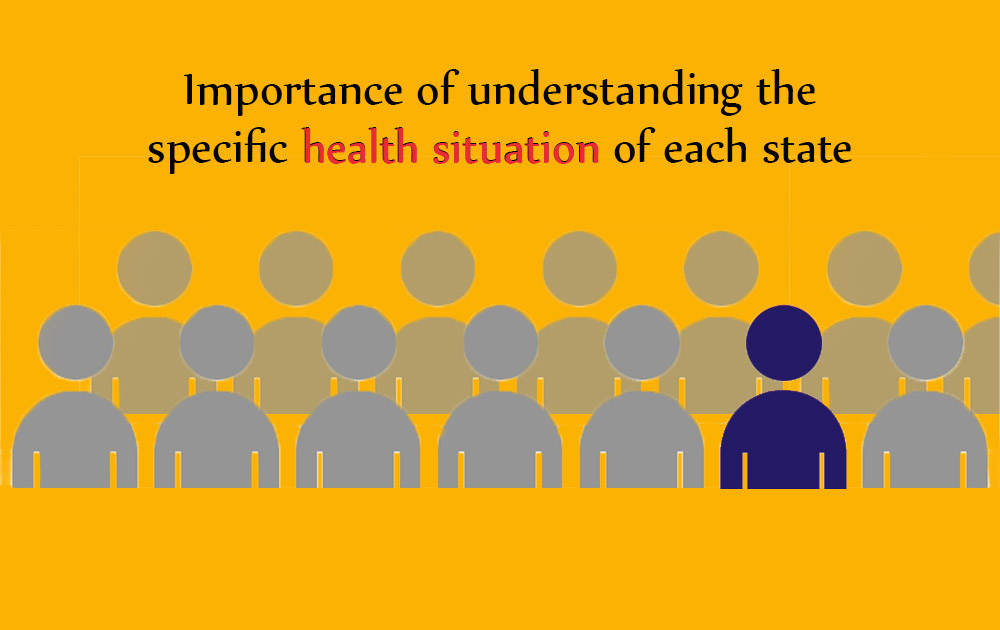Importance of understanding the specific health situation of each state
Understanding the health and disease trends in groups of states at a similar level of development or epidemiological transition is an important intermediate step in teasing apart the heterogeneity of disease and risk factor epidemiology in India. However, effective action to improve health must finally be based on the specific health situation of each state. This point is elucidated by significant variations in the burden from leading diseases and risk factors in 2016 between the following pairs of states that have physical proximity and are at similar levels of development and epidemiological transition.
The major EAG states of Madhya Pradesh and Uttar Pradesh both have a relatively lower level of development indicators and are at a similar less advanced epidemiological transition stage. However, Uttar Pradesh had 50% higher disease burden per person from chronic obstructive pulmonary disease, 54% higher burden from tuberculosis, and 30% higher burden from diarrheal diseases, whereas Madhya Pradesh had 76% higher disease burden per person from stroke.
The cardiovascular risks were generally higher in Madhya Pradesh, and the unsafe water and sanitation risk was relatively higher in Uttar Pradesh. The two North-East India states of Manipur and Tripura are both at a lower-middle stage of epidemiological transition but have quite different disease burden rates from specific leading diseases.
Tripura had 49% higher per person burden from ischaemic heart disease, 52% higher from stroke, 64% higher from chronic obstructive pulmonary disease, 159% higher from iron-deficiency anaemia, 59% higher from lower respiratory infections, and 56% higher from neonatal disorders.
Manipur, on the other hand, had 88% higher per person burden from tuberculosis and 38% higher from road injuries. Regarding the level of risks, child and maternal malnutrition, air pollution, and several of the cardiovascular risks were higher in Tripura.
The two adjoining north Indian states of Himachal Pradesh and Punjab both have a relatively higher level of development indicators and are at a similar more advanced epidemiological transition stage. However, there were striking differences between them in the level of burden from specific leading diseases.
Punjab had 157% higher per person burden from diabetes, 134% higher burden from ischaemic heart disease, 49% higher burden from stroke, and 56% higher burden from road injuries.
On the other hand, Himachal Pradesh had 63% higher per person burden from chronic obstructive pulmonary disease. Consistent with these findings, Punjab had substantially higher levels of cardiovascular risks than Himachal Pradesh.
The Executive summary says these examples highlight why it is necessary to understand the specific disease burden trends in each state, over and above the useful broad insights provided by trends common for groups of states at similar levels of epidemiological transition, if health action has to be planned for the specific context of each state.
The chances of achieving the overall health targets set by India would be much higher if the biggest health problems and risks in each state are tackled on priority than with a more generic approach that does not take into account the specific disease burden trends in each state.
Application of the state-level disease burden findings and future work. The findings in this report of the India State-level Disease Burden Initiative can be used for planning of state health budgets, prioritisation of interventions relevant to each state, informing the government’s Health Assurance Mission in each state, monitoring of health-related Sustainable Development Goals targets in each state, assessing impact of large-scale interventions based on time trends of disease burden, and forecasting population health under various scenarios in each state.
Future plans of the India State-level Disease Burden Initiative include annual updates of the estimates based on newly available data, and more disaggregated findings such as the rural-urban estimates planned for next year and sub-state level estimates subsequently when adequate data become available.
Want to write for InnoHEALTH? send us your article at magazine@innovatiocuris.com

